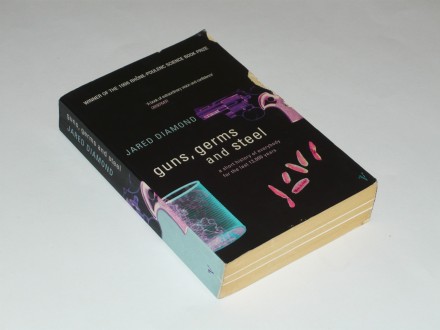Guns, Germs and Steel: A short history of everybody for
| Cena: |
| Želi ovaj predmet: | 2 |
| Stanje: | Polovan sa vidljivim znacima korišćenja |
| Garancija: | Ne |
| Isporuka: | Pošta CC paket (Pošta) Post Express Lično preuzimanje |
| Plaćanje: | Tekući račun (pre slanja)
Lično |
| Grad: |
Beograd-Zvezdara, Beograd-Zvezdara |
ISBN: 0099302780
Godina izdanja: 2005
Jezik: Engleski
Autor: Strani
Jared Diamond - Guns, Germs and Steel: A short history of everybody for the last 13,000 years
Vintage, 2005
480 str.
meki povez
stanje: dobro-, oštećenje na koricama.
Civilizations Rise and Fall #1
`Diamond has written a book of remarkable scope ... one of the most important and readable works on the human past published in recent years.`
Winner of the Pulitzer Prize and a national bestseller: the global account of the rise of civilization that is also a stunning refutation of ideas of human development based on race.
In this `artful, informative, and delightful` (William H. McNeill, New York Review of Books) book, Jared Diamond convincingly argues that geographical and environmental factors shaped the modern world. Societies that had a head start in food production advanced beyond the hunter-gatherer stage, and then developed writing, technology, government, and organized religion—as well as nasty germs and potent weapons of war—and adventured on sea and land to conquer and decimate preliterate cultures. A major advance in our understanding of human societies, Guns, Germs, and Steel chronicles the way that the modern world came to be and stunningly dismantles racially based theories of human history.
Winner of the Pulitzer Prize, the Phi Beta Kappa Award in Science, the Rhone-Poulenc Prize, and the Commonwealth Club of California`s Gold Medal
............
Guns, Germs, and Steel is a brilliant work answering the question of why the peoples of certain continents succeeded in invading other continents and conquering or displacing their peoples. This edition includes a new chapter on Japan and all-new illustrations drawn from the television series. Until around 11,000 BC, all peoples were still Stone Age hunter/gatherers. At that point, a great divide occurred in the rates that human societies evolved. In Eurasia, parts of the Americas, and Africa, farming became the prevailing mode of existence when indigenous wild plants and animals were domesticated by prehistoric planters and herders. As Jared Diamond vividly reveals, the very people who gained a head start in producing food would collide with preliterate cultures, shaping the modern world through conquest, displacement, and genocide. The paths that lead from scattered centers of food to broad bands of settlement had a great deal to do with climate and geography. But how did differences in societies arise? Why weren`t native Australians, Americans, or Africans the ones to colonize Europe? Diamond dismantles pernicious racial theories tracing societal differences to biological differences. He assembles convincing evidence linking germs to domestication of animals, germs that Eurasians then spread in epidemic proportions in their voyages of discovery. In its sweep, Guns, Germs and Steel encompasses the rise of agriculture, technology, writing, government, and religion, providing a unifying theory of human history as intriguing as the histories of dinosaurs and glaciers. Thirty-two illustrations
.............
Contents:
Prologue. Yali`s question : The regionally differing courses of history
Part One. From Eden to Cajamarca
Chapter 1. Up to the starting line : What happened on all the continents before 11,000 B.C.?
Chapter 2. A natural experiment of history : How geography molded societies on Polynesian islands
Chapter 3. Collision at Cajamarca : Why the Inca emperor Atahuallpa did not capture King Charles I of Spain
Part Two. The rise and spread of food production
Chapter 4. Farmer power : The roots of guns, germs, and steel
Chapter 5. History`s haves and have-nots : Geographic differences in the onset of food production
Chapter 6. To farm or not to farm : Causes of the spread of food production
Chapter 7. How to make an almond : The unconscious development of ancient crops
Chapter 8. Apples or Indians : Why did peoples of some regions fail to domesticate plants?
Chapter 9. Zebras, unhappy marriages, and the Anna Karenina principle : Why were most big wild mammal species never domesticated?
Chapter 10. Spacious skies and tilted axes : Why did food production spread at different rates on different continents?
Part Three. From food to guns, germs, and steel
Chapter 11. Lethal gift of livestock : The evolution of germs
Chapter 12. Blueprints and borrowed letters : The evolution of writing
Chapter 13. Necessity`s mother : The evolution of technology
Chapter 14. From egalitarianism to kleptocracy : The evolution of government and religion
Part Four. Around the world in five chapters
Chapter 15. Yali`s people : The histories of Australia and New Guinea
Chapter 16. How China became Chinese : The history of East Asia
Chapter 17. Speedboat to Polynesia : The history of Austronesian expansion
Chapter 18. Hemispheres colliding : The histories of Eurasia and the Americas compared
Chapter 19. How Africa became black : The history of Africa
Epilogue. The future of human history as a science. Who are the Japanese?
Nonfiction, History, Anthropology, 0099302780
Plaćanje pouzećem i postnetom za sada nisu opcija.
Lično preuzimanje je isključivo na Konjarniku uz prethodni dogovor.
Hvala na razumevanju.
Predmet: 76758473









